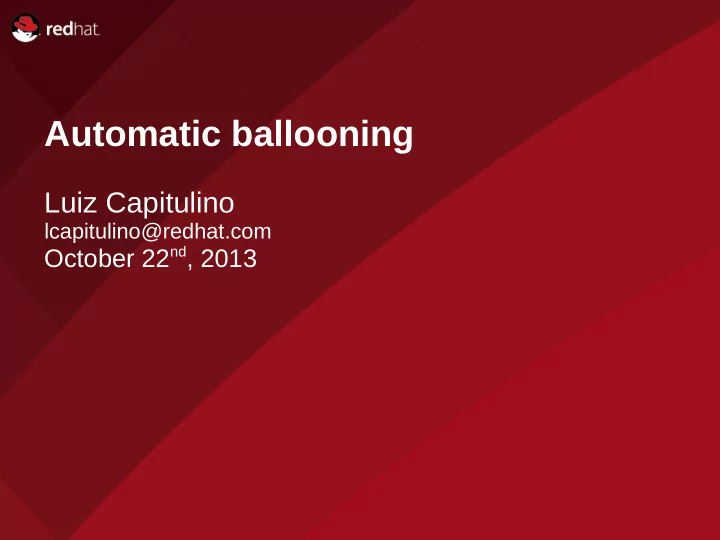

Name of Presentation Automatic ballooning Red Hat Presenter Luiz Capitulino lcapitulino@redhat.com October 22 nd , 2013 Luiz Capitulino 1
Agenda The balloon driver Making it automatic Testing & some numbers Luiz Capitulino 2
The balloon driver Luiz Capitulino 3
The balloon driver Implements two fundamental operations Inflate: memory is taken from the guest and given to the host ● Deflate: memory is taken from the host back to the guest ● Also supports statistics reporting and other features Available for Linux and Windows guests Luiz Capitulino 4
Inflate example Luiz Capitulino 5
Deflate example Luiz Capitulino 6
Balloon's primary advantage Luiz Capitulino 7
Balloon's primary disadvantage Luiz Capitulino 8
We do have to make it automatic Guests automatically shrink on host pressure Guests automatically grow when they face pressure themselves Guests are automatically managed on memory over- commited Hosts Luiz Capitulino 9
Making it automatic (Based on a design by Rik van Riel, help from Rafael Aquini) Luiz Capitulino 10
vmpressure events (auto-inflate) Added to kernel 3.10 by Anton Vorontsov Part of memory controller cgroup Defines three pressure levels LOW: the kernel is ● reclaiming memory for new allocations MEDIUM: some swapping ● may be going on CRITICAL: the system is ● thrashing, OOM killer may be on its way to trigger User-space is notified via eventfds Luiz Capitulino 11
vmpressure usage for auto-inflate QEMU registers eventfds for low, medium and critical QEMU uses pre-defined values to perform auto-inflate Low: 256 (1MB) ● Medium: 512 (2MB) ● Critical: 1024 (4MB) ● These values can be run-time tunables Luiz Capitulino 12
Auto-inflate problems/solutions Pre-defined values don't take host nor guest need into consideration Solution : the host tells the guest its facing pressure and the guest releases ● pages accordingly QEMU can get as many as 20 events when host is under pressure Solution : event throttling in QEMU (1 per sec) ● All event fds are woken up on CRITICAL level Solution : demultiplex events in QEMU ● Luiz Capitulino 13
shrink callback (auto-deflate) Drivers or subsystems can register a function to be called when the kernel is facing memory pressure The guest virtio-balloon driver implements such a function which performs auto-deflate (ie. memory is reclaimed for the guest) Luiz Capitulino 14
Auto-deflate problems/solutions The shrinker API asks for (only!) 128 pages per call Auto-deflate can be delayed due to auto-inflate taking too long Luiz Capitulino 15
A few words on the current status A prototype exists for almost a year Still pretty experimental ● Two RFC versions posted upstream Need more feedback! ● Luiz Capitulino 16
Testing Luiz Capitulino 17
Take it with a grain of salt Very hard to come up with a good test-case Smallest change in parameters can change the results Several scenarios to be tested Luiz Capitulino 18
A very simple test-case Luiz Capitulino 19
Test results: 10 runs average Vanilla auto-ballon Difference % Total run time (sec) 441 441 0% Pages swapped in 46346 41898 -9.60% (host) Pages swapped out 209710 196080 -6.50% (host) Specjbb throughput 57378.96 58086.61 +1.23% – VMs (bops) Luiz Capitulino 20
That's all folks! Luiz Capitulino <lcapitulino@redhat.com> http://www.linux-kvm.org/Projects/auto-ballooning Luiz Capitulino 21
Recommend
More recommend